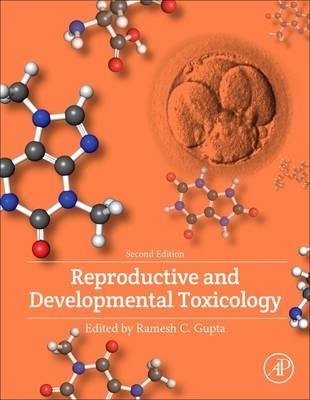
Reproductive and Developmental Toxicology
Academic Press Inc (Verlag)
978-0-12-804239-7 (ISBN)
- Titel erscheint in neuer Auflage
- Artikel merken
With a special focus on placental toxicity, this book is the only available reference to connect the three key risk stages, also including discussions on reproductive and developmental toxicity in domestic animals, fish, and wildlife.
Completely revised and updated to include the most recent developments in the field, the book is an essential resource for advanced students and researchers in toxicology, as well as biologists, pharmacologists, and teratologists from academia, industry, and regulatory agencies.
Dr. Ramesh C. Gupta, Professor & Head of Toxicology Department at Murray State university, is engaged in experimental brain research in relation to Alzheimer’s disease (AD) and pesticide toxicity. He has delivered lectures in Australia, Italy, Japan, Germany, France, Switzerland, Spain, Czech Republic, China, South Korea, and Sweden. He served the panels of NIH, CDC, NIOSH, and NAS. He has >350 publications to his credit, including seven major books with Elsevier: (1) Toxicology of Organophosphate and Carbamate Compounds, (2) Veterinary Toxicology: Basic and Clinical Principles, (3) Handbook of Toxicology of Chemical Warfare Agents, (4) Anticholinesterase Pesticides: Metabolism, Neurotoxicity, and Epidemiology, (5) Reproductive and Developmental Toxicology, (6) Biomarkers in Toxicology and (7) Neutraceuticals. He is recipient of Murray State University's distinguished researcher award of the year-2006. He is a diplomate of American Board of Toxicology, and fellow of American College of Toxicology, American College of Nutrition, and Academy of Toxicological Sciences.
Section I. General1. Introduction2. Reproductive Anatomy and Physiology3. Pharmacokinetics in Pregnancy4. Physiologically Based Pharmacokinetic Models in Reproductive and Developmental Toxicology5. Drugs and Chemical Contaminants in Human Breast Milk
Section II. Toxicity Testing Models and Safety Evaluation6. Reproductive and Developmental Safety Evaluation of New Pharmaceutical Compounds7. Juvenile Toxicology Testing8. Postmarket Surveillance and Regulatory Considerations in Reproductive and Developmental Toxicology: A Food and Drug Administration Perspective9. OECD Guidelines for In Vivo Testing of Reproductive Toxicity10. Guidelines for Reproductive and Developmental Toxicity Testing and Risk Assessment of Chemicals11. Validated and Nonvalidated Mechanism-Based Methods for Testing Developmental Toxicity12. Relevance of Animal Testing and Sensitivity of End Points in Reproductive and Developmental Toxicity13. Embryonic Toxic Lesions and Stem Cell Therapy14. In Vitro and Alternative Approaches to Developmental Neurotoxicity15. In Vitro Biomarkers of Developmental Neurotoxicity16. Using Zebrafish to Assess Developmental Neurotoxicity17. Caenorhabditis elegans as a Model to Assess Reproductive and Developmental Toxicity18. A Primate as an Animal Model for Reproductive and Developmental Toxicology Testing
Section III. Nanoparticles and Radiation19. Developmental Toxicity of Engineered Nanomaterials20. Toxicity of Radiation: Biological Effects of Ionizing Radiation Exposure on Reproduction
Section IV. Gases and Solvents21. Reproductive and Developmental Toxicity of Solvents and Gases
Section V. Drugs of Abuse and Addiction, Smoking and Alcohol22. Caffeine23. Developmental Neurotoxicity of Abused Drugs24. Effects of Alcohol on Embryo/Fetal Development25. Cigarette Smoking and Reproductive and Developmental Toxicity
Section VI. Pharmaceuticals and Food Additives26. Thalidomide27. Retinoids28. Melamine and Cyanuric Acid29. Ionophores
Section VII. Metals30. Boron31. Arsenic, Cadmium, and Lead32. Manganese33. Mercury34. Selenium
Section VIII. Pesticides, Industrial and Other Environmental Contaminants35. Organophosphates and Carbamates36. Chlorinated Hydrocarbons and Pyrethrins/Pyrethroids37. Herbicides and Fungicides38. Brominated Flame Retardants39. Polychlorinated Biphenyls, Polybrominated Biphenyls, Polychlorinated Dibenzo-p-dioxins, and Polychlorinated Dibenzofurans40. Reproductive Toxicity of Polycyclic Aromatic Hydrocarbons41. Toxicity and Risk Assessment of Bisphenol A42. Ethylene Glycol43. Perfluorooctane Sulfonate and Perfluorooctanoic Acid44. Phthalates45. Personal Care Products and Cosmetics
Section IX. Phytotoxicants, Mycotoxins and Zootoxins46. Toxic plants47. Fumonisins48. Aflatoxins, Ochratoxins, and Citrinin49. Zootoxins
Section X. Special Topics50. Systems Toxicology and Predictive Modeling of Male Developmental Toxicity51. Stem Cells in Developmental Toxicity Testing52. Epigenetics in Reproduction and Development53. Mitochondrial Dysfunction in Reproductive and Developmental Toxicity54. Cell Signaling Mechanisms in Developmental Neurotoxicity55. Neuroinflammation and Oxidative Injury in Developmental Neurotoxicity56. Effects of Stress on Reproductive and Developmental Biology57. Disruption of Cholesterol Homeostasis in Developmental Neurotoxicity
Section XI. Endocrine Disruption, Mutagenicity, Carcinogenicity, Infertility and Teratogenicity58. Endocrine Disruption59. Developmental and Reproductive Disorders—Role of Endocrine Disruptors in Testicular Toxicity60. Mutagenicity and Carcinogenicity: Human Reproductive Cancer and Risk Factors61. Environmental Pollutants and Neural Tube Defects62. Teratogenicity63. Micro–Computed Tomography and Volumetric Imaging in Developmental Toxicology
Section XII. Toxicologic Pathology64. Toxicologic Pathology of the Reproductive System
Section XIII. Placental Toxicity65. The Placental Role in Developmental Programming66. Strategies for Investigating Hemochorial Placentation67. The Significance of ABC Transporters in Human Placenta for the Exposure of Fetus to Xenobiotics68. Placental Toxicity69. Placental Pathology
Section XIV. Domestic and Wildlife Species70. Reproductive and Developmental Toxicity in Avian Species71. Endocrine Disruption in Wildlife Species72. Teratogenesis in Livestock
| Erscheinungsdatum | 04.06.2017 |
|---|---|
| Verlagsort | San Diego |
| Sprache | englisch |
| Maße | 216 x 276 mm |
| Gewicht | 3100 g |
| Themenwelt | Studium ► 1. Studienabschnitt (Vorklinik) ► Histologie / Embryologie |
| Studium ► 2. Studienabschnitt (Klinik) ► Pharmakologie / Toxikologie | |
| ISBN-10 | 0-12-804239-7 / 0128042397 |
| ISBN-13 | 978-0-12-804239-7 / 9780128042397 |
| Zustand | Neuware |
| Informationen gemäß Produktsicherheitsverordnung (GPSR) | |
| Haben Sie eine Frage zum Produkt? |
aus dem Bereich



